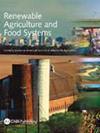The effects of farming system and soil management on floristic diversity in sloping olive groves
IF 2
3区 农林科学
Q2 AGRICULTURE, MULTIDISCIPLINARY
引用次数: 2
Abstract
Abstract The effects of the farming system (conventional-organic-abandoned) and soil management (native cover crop vs tillage) on vascular plant species were analyzed in sloping olive groves (>20%) in 20 different locations in Andalusia, SE Spain. The soil management techniques included Organic Tillage (OT), Organic Cover Crops (OC), Conventional Tillage (CT), Conventional Non-Tillage (CNT), Abandoned Cover Crops (AC) and Abandoned Woody (AW). Data for the vascular plant species were recorded through three line transects of 30 m with a bar perpendicularly touching every 1 m of the measuring tape. Environmental variables were also recorded at plot level to assess their influence. Dependent variables, such as species abundance, richness and diversity indexes were studied using univariate analysis (one-way ANOVA, Kruskal–Wallis test) while multivariate statistics (ANOSIM, SIMPER, DCA) were used for analyzing the data matrices. We found that the different combinations of farming system and soil management affect biological diversity in terms of individual abundance, plant cover, species richness and diversity, species and family composition. Life forms and species distribution patterns are also affected. The main environmental variables affecting the plant taxa were those related with soil and climate characteristics, slope, olive age and intensive land uses at landscape level, including the percentage of artificial surfaces. The lowest levels of biodiversity (e.g., species richness) were found in the tilled olive groves (CT = 8.1 sp. ± 2.2, OT = 10.0 sp. ± 5.4). Surprisingly, the organic tilled groves (OT) were very poor in species compared to those with native plant cover (OC = 27.9 sp. ± 3.0). The latter, however, showed similar species richness to the abandoned olive groves (AC = 21.2 sp. ± 3.7, AW = 27.2 sp. ± 3.0). Possible solutions for increasingly uncompetitive sloping olive groves include conversion to organic with native plant cover or abandonment for rewilding.耕作制度和土壤管理对坡地橄榄园植物区系多样性的影响
在西班牙东南部安达卢西亚20个不同地点的坡地橄榄园(> - 20%)中,分析了耕作制度(常规-有机放弃)和土壤管理(原生覆盖作物vs耕作)对维管植物物种的影响。土壤管理技术包括有机耕作(OT)、有机覆盖作物(OC)、常规耕作(CT)、常规免耕(CNT)、废弃覆盖作物(AC)和废弃木本作物(AW)。维管植物物种的数据通过三条30米的线样线记录,每隔1米垂直接触一根杆。还记录了小区水平的环境变量,以评估其影响。因变量包括物种丰度、丰富度和多样性指数,采用单因素分析(单因素方差分析、Kruskal-Wallis检验),多因素统计(ANOSIM、SIMPER、DCA)对数据矩阵进行分析。研究发现,不同的耕作制度和土壤管理组合在个体丰度、植物覆盖度、物种丰富度和多样性、物种和科组成等方面影响生物多样性。生命形式和物种分布格局也受到影响。影响植物分类群的主要环境变量是与土壤和气候特征、坡度、橄榄树年龄和景观水平上的土地集约利用有关的环境变量,包括人工地表的百分比。生物多样性(如物种丰富度)最低的是耕作过的橄榄园(CT = 8.1 sp.±2.2,OT = 10.0 sp.±5.4)。令人惊讶的是,与原生植被覆盖的林地相比,有机耕作林(OT)的物种数量非常少(OC = 27.9 sp.±3.0)。后者的物种丰富度与废弃橄榄林相似(AC = 21.2 sp.±3.7,AW = 27.2 sp.±3.0)。对于日益缺乏竞争力的坡地橄榄园,可能的解决方案包括转向有机种植,并覆盖本地植物,或者放弃种植,重新放归野生。
本文章由计算机程序翻译,如有差异,请以英文原文为准。
求助全文
约1分钟内获得全文
求助全文
来源期刊

Renewable Agriculture and Food Systems
农林科学-农业综合
CiteScore
5.20
自引率
7.40%
发文量
39
审稿时长
>36 weeks
期刊介绍:
Renewable Agriculture and Food Systems (formerly American Journal of Alternative Agriculture) is a multi-disciplinary journal which focuses on the science that underpins economically, environmentally, and socially sustainable approaches to agriculture and food production. The journal publishes original research and review articles on the economic, ecological, and environmental impacts of agriculture; the effective use of renewable resources and biodiversity in agro-ecosystems; and the technological and sociological implications of sustainable food systems. It also contains a discussion forum, which presents lively discussions on new and provocative topics.
 求助内容:
求助内容: 应助结果提醒方式:
应助结果提醒方式:


